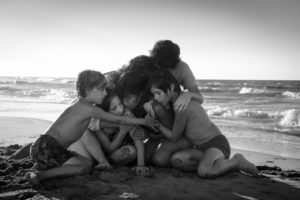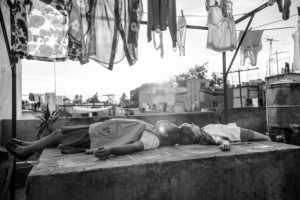Dear Artist,
“You have a first image,” said Mexican director Alfonso Cuarón, when describing his inspiration for his new film, Roma. “You just know that it is always going to be there. You don’t question that.” In Roma, almost every scene is meticulously composed and timed in a wide-angle tableau of human drama and staggering beauty. Drawn exclusively from Cuarón’s childhood memories, the film is shot from the perspective of his beloved nanny, Libo, and tells the story of her inner and outer life as an indigenous Mixtec domestic worker in 1970s Mexico City.
In painting and still photography, “tableau” is a figurative scene where characters are arranged in a composition to maximize beauty and dramatic effect. Originally a response to the conventions of portraiture, tableau characters are absorbed in drama and unaware of the existence of a viewer. French philosopher Denis Diderot assigned the term in the 18th Century to distinguish paintings that are beautifully composed, but still feel natural and believable, and include the important feature of the viewer being walled off, but able to look in. One hundred years later, Édouard Manet set a party on a picnic blanket facing outward to confront the viewer. To Manet, this approach shattered the idealism of tableau in favour of shocking eye contact between the subject and viewer. In 1959, French filmmaker Jean Renoir set Manet’s 1863 painting to film in his romance-comedy, Le Déjeuner sur l’herbe, a set-up Cuarón was keenly aware of when arranging his own picnic tableau in Roma. In order to evolve compositional conventions, Cuarón kept the screenplay from his actors, shot the film chronologically and only revealed plot essentials at the last minute. While some major sequences were rehearsed ahead of time, stand-ins were used to capture the real-time responses of both key and minor characters during filming. The effect is a straddling of Cuarón’s idealized lens of childhood memories and the breathtaking realities of Libo’s real-life story.
Sincerely,
Sara
PS: “I was just going to go for it. I wanted this to be about trusting these moments, whatever was going to come out. I didn’t want to be thinking about narrative, and this is the first project where I didn’t want to have any references.” (Alfonso Cuarón)
Esoterica: When his cinematographer was unable to participate due to scheduling conflicts, Cuarón shot the film himself on two borrowed and untried Arri 65 mm Alexa digital cameras known for their infinite range of values in black and white and total absence of graininess. This delivered a contemporary sharpness and realism, designed to look into the past without the soft-focus cliché of nostalgia. Cuarón also found a house, set for demolition, in the middle-class neighbourhood of Roma, Mexico City — across the street from and almost identical to the one he grew up in — and, with the help of his team, filled it with the furnishings of his own childhood home. He also had the roof removed to allow natural light into his shots. You can watch Alfonso Cuarón’s tableau Masterpiece Roma on Netflix, where it was released for digital streaming in November.
“I’m interested in new worlds, new universes, new challenges. I always said the only reason to make a film is not for the result but for what you learn for the next one.” (Alfonso Cuarón)
 Have you considered joining our Premium Artist Listings? Share your work with thousands of readers. 100% of your listing fee contributes to the production of The Painter’s Keys. Thanks for your friendship.
Have you considered joining our Premium Artist Listings? Share your work with thousands of readers. 100% of your listing fee contributes to the production of The Painter’s Keys. Thanks for your friendship.
“There is only one passion, the passion for happiness.” (Denis Diderot)
Featured Artist
My art represents a journey that has been on-going for more than forty years. Guidance from some wonderful artists. Years of plein-air painting and instructing have developed a style that I can call my own. I believe that my current work has attained its highest level so far, reflecting the depth of my absorption in the wonder and beauty of the world around me. I have learned that, as an artist, I will never stop looking for better ways to express my feelings in art and that struggling to more fully understand myself is integral to my painting; a philosophy that was part of every workshop that I gave – and remains true today.







6 Comments
I loved the cinematography of the film, but the plot did little for me. Visually it was, however, a picnic! I have a feeling that a lot of people will read the reviews and decide not to look at the film because the plot is so tame. They’ll be missing a lot.
A great insight into the film, thank you. I had enjoyed it immensely but now that I read about Cuaron’s personal relationship with the project, I am appreciating it more than ever. I hope it wins well this coming Sunday night at the Oscars. It is muchly deserving of recognition.
I grew up in ‘La Roma’ neighbour in Mexico city,. My time was a bit ahead but I still lived my childhood in the 70’s. It brought me back memories, for me as a roman, I can say it is a wonderful movie, despite the fact few innacuracies I was able to note!
I watched the movie last night after reading painters keys. It was so beautiful, every frame, for tonal composition alone, there were times when I wanted to press pause, just to look longer and deeper, but the scenes moved like a seamless visual ballet of objects and textures and space, layered with the complexities of ordinary magic, of sparks from a fire in the woods at dusk, smoke from a gun, planes drifting in the sky like they are not miracles at all, the steady unhurried consistency and presence of the main character, her black hair like silk, like dog, like depth itself, drawing wide geometrical shapes within the space, dipping and embracing and rolling like a wave, appearing and disappearing in seamless sync, in gentleness and strength, in a world of solid and ethereal things dissolving and revolving and shot through with the foot steps of running children.
I watched for how it looked, I will watch again for what it makes me see. Thank you Mr. Cuaron. A remarkable work of art. XC
“Roma” rewards deep, and repeated viewings.
My first encounter was on my laptop screen, the second in a movie theatre with surround sound. I observed so much more seeing it on the big screen, and understood nuances (beyond nuances) in the storytelling and settings. My third ‘viewing’ was seeing a photographic installation featuring key scenes in Roma at LACMA (Los Angeles County Museum of Art).
Each encounter, like viewing a complex piece of visual art, is a revelation.
The daily challenges in Worldguessr keep the gameplay fresh and exciting. Every day brings a new location to guess, keeping players engaged and motivated to improve.